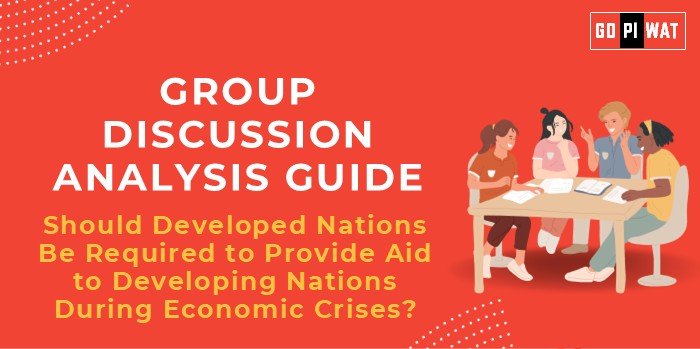📋 Group Discussion (GD) Analysis Guide
🌐 Should Developed Nations Be Required to Provide Aid to Developing Nations During Economic Crises?
📖 Introduction to the Topic
Opening Context: Economic crises often exacerbate global inequalities, disproportionately impacting developing nations. The moral, political, and economic responsibility of developed nations to assist is an enduring debate.
Topic Background: Rooted in international solidarity, the debate over aid obligations gained momentum post-World War II and resurged during recent crises like COVID-19. Institutions like the IMF and World Bank have been key players in structuring aid frameworks.
📊 Quick Facts and Key Statistics
- 🌍 Global Aid Flow: $161.2 billion in Official Development Assistance (ODA) in 2022 (OECD).
- 💸 Poverty Impact: Over 700 million people globally live on less than $2.15 a day (World Bank).
- 📉 COVID-19 Fallout: Developing countries experienced a GDP drop of 2.1% in 2020 compared to 1.3% in developed nations (IMF).
- 💵 Debt Burden: External debt in low-income countries rose to $861 billion in 2023 (World Bank).
🌟 Stakeholders and Their Roles
- 🏛️ Developed Nations: Provide financial aid, technology transfer, and policy support.
- 🌍 Developing Nations: Utilize aid for recovery, infrastructure, and poverty alleviation.
- 🌐 International Organizations: Facilitate and monitor aid flows (e.g., IMF, World Bank).
- 🤝 NGOs and Civil Societies: Advocate for equitable aid distribution and grassroots implementation.
🏆 Achievements and Challenges
✨ Achievements
- ✅ Economic Recovery: Post-2008 financial aid packages helped stabilize developing economies.
- 💉 Health Interventions: Funding during pandemics reduced mortality rates in vulnerable regions.
- 🎓 Education and Technology: Initiatives like GAVI improved vaccination coverage in Africa.
⚠️ Challenges
- ⚖️ Aid Dependency: Over-reliance undermines self-sufficiency.
- 💸 Corruption: Inefficient fund utilization erodes trust.
- 📉 Donor Fatigue: Increasing crises strain donor nations’ willingness and capacity.
📘 Global Comparisons:
– Success: Post-tsunami aid in Southeast Asia accelerated regional recovery.
– Challenges: Aid to Haiti post-2010 earthquake faced mismanagement criticisms.
– Case Studies:
– Rwanda: Effective utilization of development aid for health and infrastructure.
– Afghanistan: Aid mismanagement due to political instability.
💬 Structured Arguments for Discussion
- ✅ Supporting Stance: “Developed nations bear a moral responsibility to assist those disproportionately affected by global economic imbalances.”
- ❌ Opposing Stance: “Aid fosters dependency and often comes with strings attached, limiting developing nations’ autonomy.”
- ⚖️ Balanced Perspective: “Aid is essential in emergencies but should focus on sustainable, mutual benefit partnerships.”
💡 Effective Discussion Approaches
- 🌏 Opening Techniques:
- Highlight global inequality with statistics.
- Reference case studies showing effective aid use.
- Quote experts advocating for ethical responsibilities.
- 🤔 Counter-Argument Handling:
- Acknowledge limitations and suggest reforms like transparency and local engagement in aid utilization.
🔍 Strategic Analysis of Strengths and Weaknesses
- 💪 Strengths: Ethical justification; economic stabilization.
- ⚖️ Weaknesses: Corruption risks; donor fatigue.
- 📈 Opportunities: Strengthening global ties; innovation in aid delivery.
- ⚠️ Threats: Political misuse; resistance to aid conditions.
🎓 Connecting with B-School Applications
- 🌍 Real-World Applications: Explore themes in global finance, operations strategy, or ethical business leadership.
- 💬 Sample Questions:
- “How can aid models be redesigned to ensure effectiveness?”
- “What role do corporations play in supplementing international aid?”
- 💡 Insights for Students:
- Understanding international finance, ethical leadership, and global supply chain resilience.


